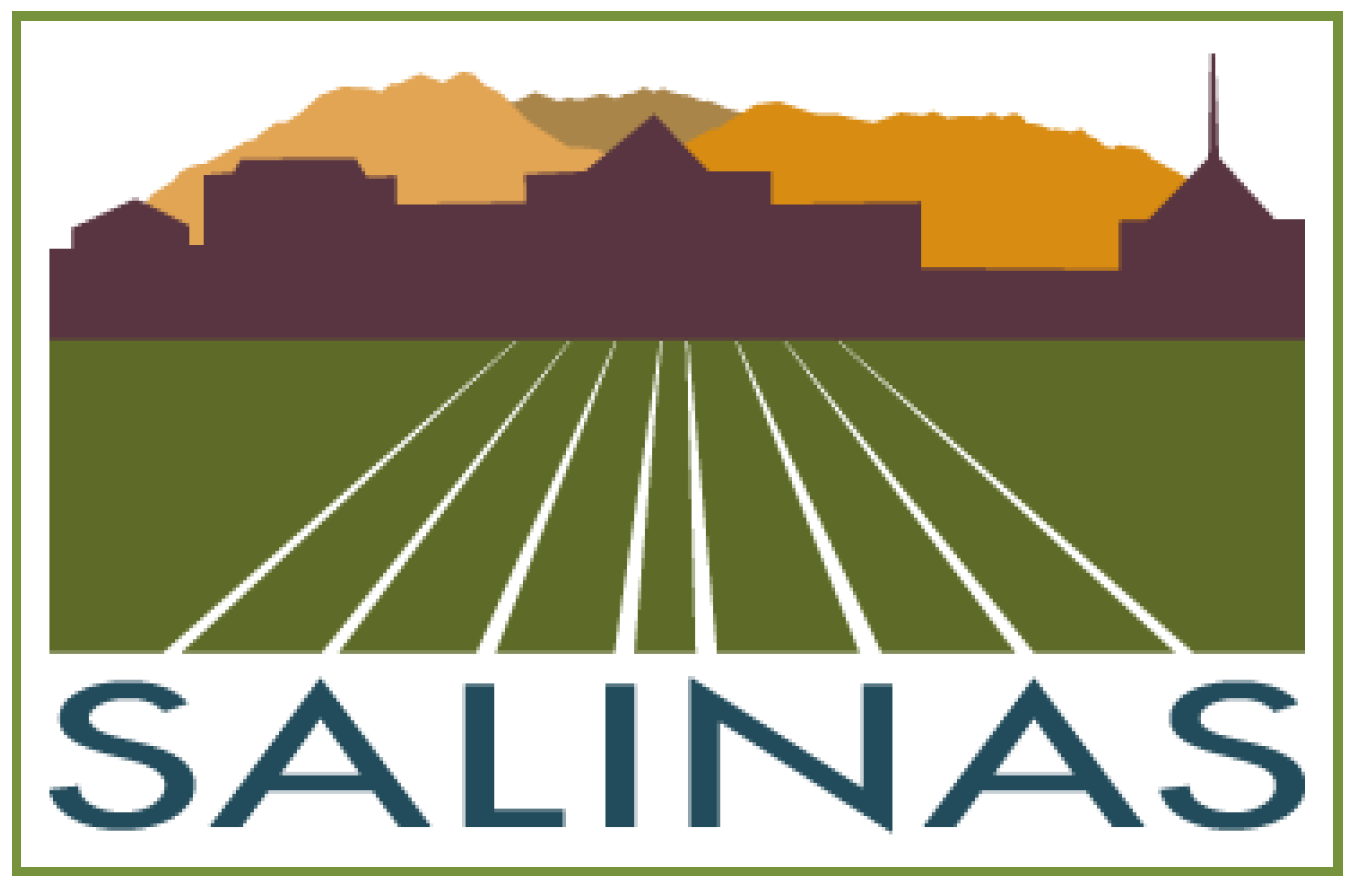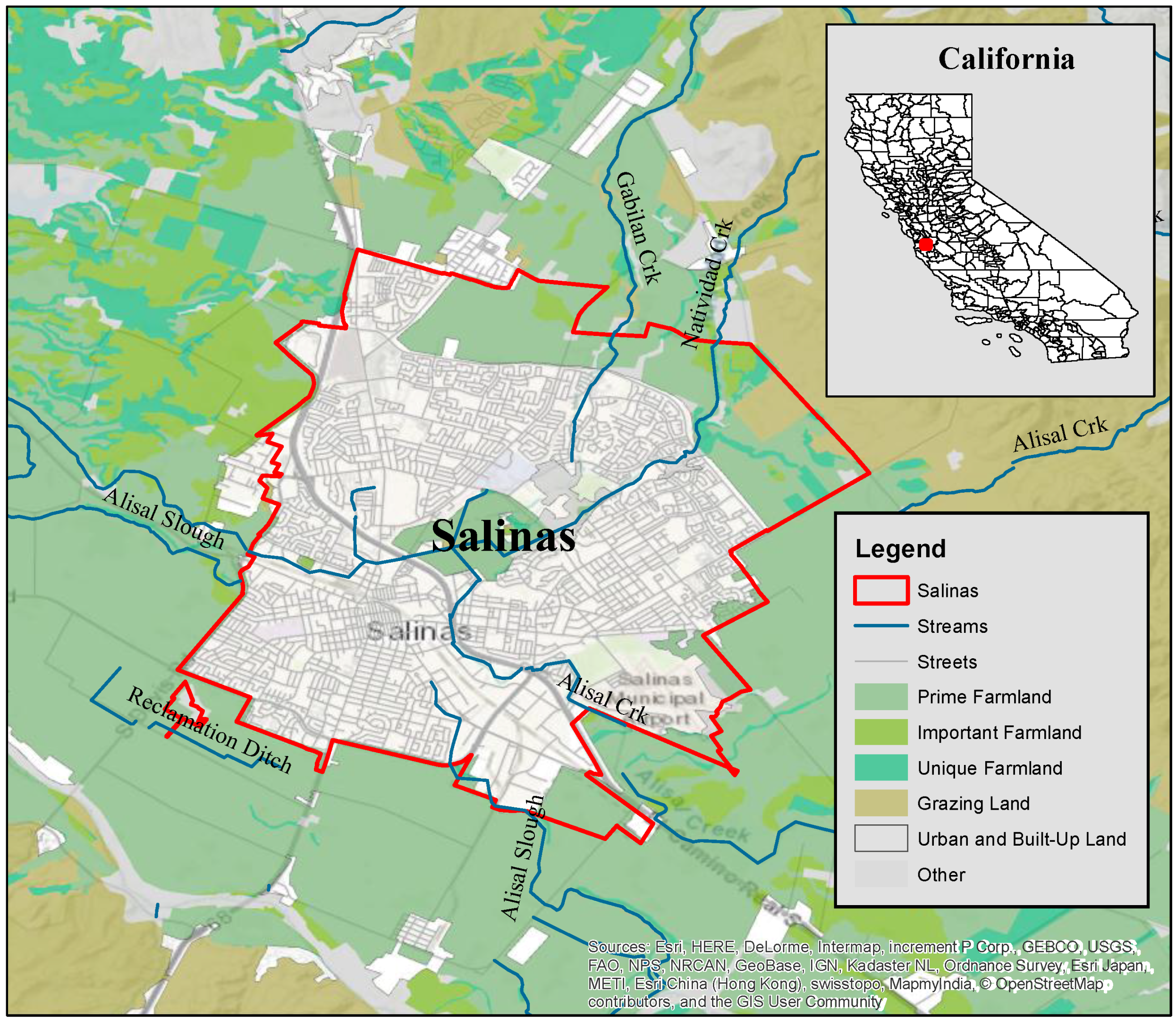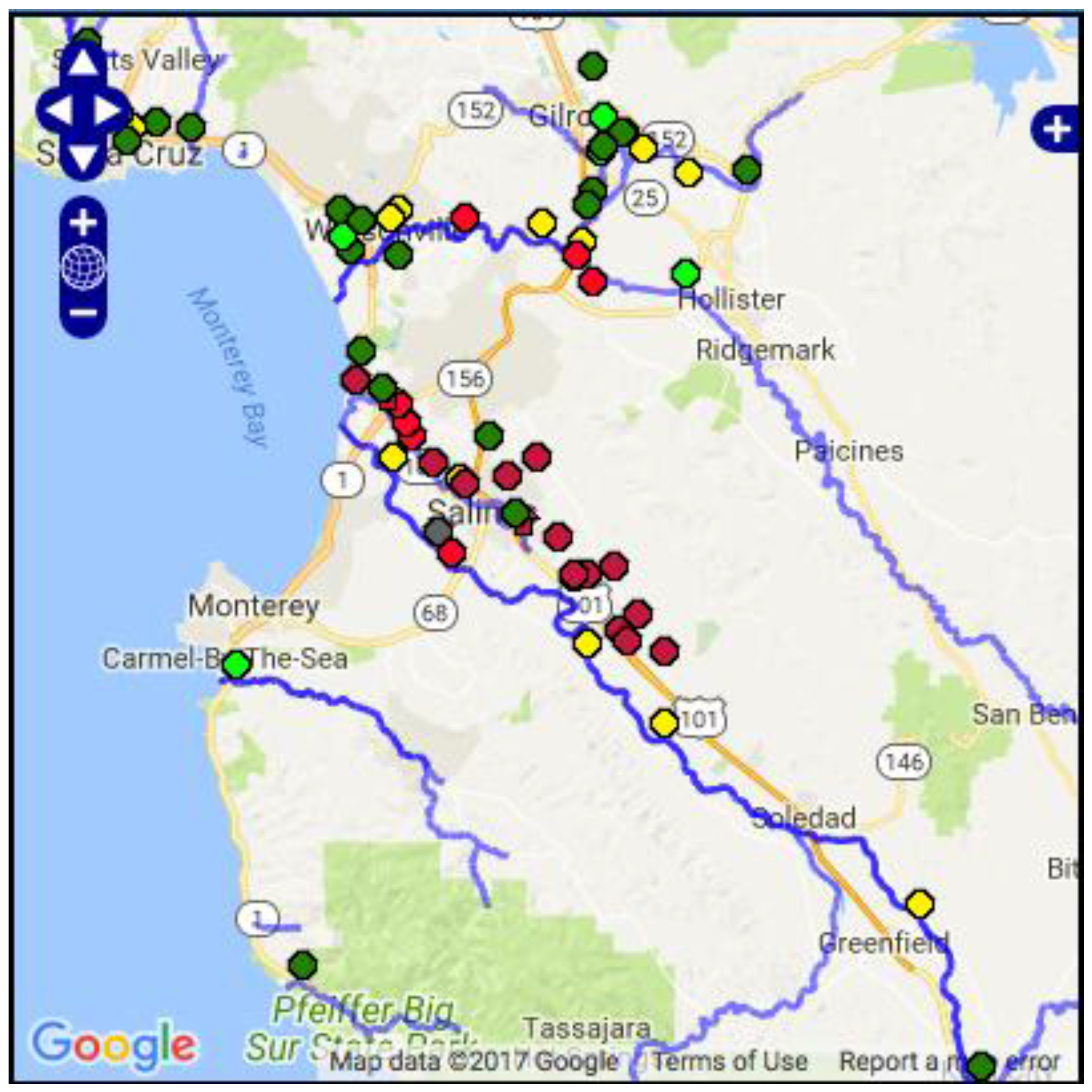From Fragmented to Joint Responsibilities: Barriers and Opportunities for Adaptive Water Quality Governance in California’s Urban-Agricultural Interface
Abstract
:1. Introduction
2. Research Design and Methods
3. The Cumulative Toxic Brew in the Urban-Agriculture Interface
4. Divergent Laws in Merging Waters
5. Adaptive Legal Frameworks
5.1. Sustainable Groundwater Management Act
5.2. Human Right to Water Act
5.3. Affordable Drinking Water Bill (Proposed)
6. Case Study
Salinas, California
“As operator of the MS4, the Permittee cannot passively receive and discharge pollutants from third parties. By providing free and open access to an MS4 that conveys discharges to waters of the U.S., the Permittee essentially accepts responsibility for discharges into the MS4 that it does not prohibit or control. These discharges may cause or contribute to a condition of contamination or a violation of water quality standards. However, discharges from agricultural lands that are comprised solely of return flows and/or storm water are exempt from NPDES permitting. As such, the Permittee is not responsible for these discharges that enter its MS4. The Permittee is responsible for other agricultural-related discharges into its MS4.”
“Water that begins its journey in the relatively undisturbed Gabilan and Santa Lucia Mountains drains farmlands and other cities and developed areas before entering Salinas. Once in the City, water passes through municipal neighborhoods before re-entering farmlands, then flows on to more urban uses. Water flows out of Salinas to re-enter more farmland before draining ultimately to Monterey Bay. On its journey, water flows through several different land uses, some more than once and often through several different jurisdictions” [23].
7. Conclusions: From Fragmented to Joint Responsibilities
“It is difficult to imagine a legal and policy regime as fractured as that used to govern water resources in the United States. Connected issues are addressed without coordination and authority is divided among federal, state and local entities that have little incentive to coordinate their interrelated actions.”—Robert W. Adler, Professor of Law
Acknowledgments
Conflicts of Interest
References
- Chappelle, C.; Hanak, E. California’s Water Quality Challenges; Public Policy Institute of California: October, 2015; Available online: http://www.ppic.org/content/pubs/jtf/JTF_WaterQualityJTF.pdf (accessed on 5 November 2017).
- National Aeronautics and Space Administration (NASA). NASA Analysis: 11 Trillion Gallons to Replenish California Drought Losses; NASA publication 14-333; NASA: Washington, DC, USA, 2014.
- Goldenberg, S. The Central Valley is Sinking: Drought Forces Farmers to Ponder the Abyss; The Guardian: London, UK, 2015. [Google Scholar]
- United State Environmental Protection Agency (EPA). Assessment TMDL Tracking and ImplementatioN System (ATTAINS); USEPA: Washington, DC, USA, 2012.
- California Department of Water Resources (CA DWR). Available online: www.water.ca.gov/climatechange/ (accessed on 2 November 2017).
- Harter, T.; Lund, J.; Darber, J.; Fogg, G.; Howitt, R.; Jessoe, K.; Pettygrove, S.; Quinn, J.; Viers, J. Addressing Nitrate in California’s Drinking Water; SBX2-1; Center for Watershed Sciences, University of California: Davis, CA, USA, 2012. [Google Scholar]
- Knobeloch, L.; Salna, B.; Hogan, A.; Postle, J.; Anderson, H. Blue babies and nitrate contaminated well water. Environ. Perspect. 2000, 108, 675–678. [Google Scholar] [CrossRef]
- International Human Rights Law Clinic (IHRLC). The Human Right to Water Bill in California: An Implementation Framework for State Agencies; University of California, Berkeley, School of Law: Berkeley, CA, USA, 2013. [Google Scholar]
- Shilling, F.; Sommarstrom, S.; Kattelman, R.; Florsheim, J.; Henly, R.; Washburn, B. The California Watershed Assessment Manual; California Resource Agency: Sacramento, CA, USA, 2005.
- United States Environmental Protection Agency (EPA). National Water Quality Inventory; EPA: Washington, DC, USA, 2010.
- Andreen, W.L. Water quality today: Has the Clean Water Act Been a Success? Ala. Law Rev. 2004, 55, 537–593. [Google Scholar]
- Anderson, B.S.; Hunt, J.W.; Phillips, B.M.; Nicely, P.A.; Vlaming, V.; Connor, V.; Richard, N.; Tjeerdema, R.S. Integrated assessment of the impacts of agricultural drainwater in the Salinas River. Environ. Pollut. 2003, 124, 523–532. [Google Scholar] [CrossRef]
- Anderson, B.S.; Phillips, B.M.; Hunt, J.W.; Connor, W.; Richard, N.; Tjeerdema, R.S. Identifying primary stressors impacting macroinvertebrates in the Salinas River: Relative effects of pesticides and suspended particles. Environ. Pollut. 2006, 141, 402–408. [Google Scholar] [CrossRef] [PubMed]
- Anderson, B.; Hunt, J.; Markiewics, D.; Larsen, K. Toxicity in California Waters. Surface Water Ambient Monitoring Program; California State Water Resources Control Board: Sacramento, CA, USA, 2011.
- Pereira, W.; Domagalski, J.; Hostettler, F.; Brown, L.; Rapp, J. Occurrence and accumulation of pesticides and organic contaminants in river sediment, water and clam tissues from the San Joaquin River and tributaries, California. Environ. Toxicol. Chem. 1996, 15, 172–180. [Google Scholar] [CrossRef]
- Paul, M.; Meyer, J. Streams in the urban landscape. Ann. Rev. Ecol. Syst. 2001, 32, 333–365. [Google Scholar] [CrossRef]
- Roy, A.H.; Wenger, S.H.; Fletcher, T.D.; Walsh, C.J.; Ladson, A.R.; Shuster, W.D.; Thurston, H.W.; Brown, R.R. Impediments and solutions to sustainable, watershed-scale urban stormwater management: Lessons from Australia and the United States. Environ. Manag. 2008, 42, 344–359. [Google Scholar] [CrossRef] [PubMed]
- United States Environmental Protection Agency (EPA). National Pollutant Discharge Elimination System (NPDES): Sanitary Sewer Overflows (SSOs); EPA: Washington, DC, USA, 2016.
- Otter Project; Monterey Coastkeeper; PCFFA; Environmental Justice Coalition for Water; Santa Barbara Channelkeeper; Sportfishing Protection Alliance. “Judge Rules State Must Do Much More to Curb Agricultural Pollution.” (Press Release). Available online: http://mavensnotebook.com/wp-content/uploads/2015/08/Press-Release-Ag-Order-Win.pdf (accessed on 1 December 2017).
- Monterey Coastkeeper; The Otter Project; PCFFA; Environmental Justice Coalition for Water; Santa Barbara Channelkeeper; Sportfishing Protection Alliance v. California State Water Resources Control Board (SWRCB); Case Number: 34-2012-80001324; Superior Court of California, County of Sacramento: Sacramento, CA, USA, 2015. [Google Scholar]
- Meurer, F. Letter to the Regional Board Posted in: Transcripts of Proceedings; Meeting minutes; Central Coast Regional Water Quality Control Board: San Luis Obispo, CA, USA, 2011.
- Poteete, A.R. Levels, scales, linkages, and other ‘multiples’ affecting natural resources. Int. J. Commons. 2012, 6, 134–150. [Google Scholar] [CrossRef]
- City of Salinas. Stormwater Management Plan Update. 2013. Available online: https://www.cityofsalinas.org/our-city-services/public-works/water-waste-energy/stormwaterwater-recycling/stormwater-documents-3 (accessed on 1 November 2017).
- City of Salinas Municipal Storm Water Discharges Technical Report. 2012. Available online: https://www.waterboards.ca.gov/rwqcb3/water_issues/programs/stormwater/docs/salinas/2012_0005_salinas_fact_sheet.pdf (accessed on 14 November 2017).
- Central Coast Ambient Monitoring Program (CCAMP). Available online: http://www.ccamp.org/ (accessed on 20 November 2017).
- Surface Ambient Monitoring Program (SWAMP). Available online: https://www.waterboards.ca.gov/water_issues/programs/swamp/ (accessed on 10 November 2017).
- Adler, R.W.; Straube, M. Watersheds and the Integration of U.S. Water Law and Policy: Bridging the Great Divides; William & Mary Environmental Law Policy Review: Williamsburg, VA, USA, 2010; Volume 25. [Google Scholar]
- Pure Water Monterey. Available online: http://purewatermonterey.org/ (accessed on 13 November 2017).
- Salamon, L.M. The new governance and the tools of public action: An introduction. In Tools of Government: A Guide to the New Governance; Oxford University Press: New York, NY, USA, 2002; pp. 1–47. [Google Scholar]
- Drevno, A. Policy Tools for Agricultural Nonpoint Source Water Pollution Control in the U.S. and E.U. J. Manag. Environ. Qual. 2016, 37, 106–123. [Google Scholar] [CrossRef]




| Scale of Governance | Agency | Goal |
|---|---|---|
| Federal | 1972 Clean Water Act | Regulates water pollution; adopts water quality standards |
| Safe Drinking Water Act | Establishes drinking water standards for contaminants that may cause health effects | |
| Endangered Species Act | Prevent extinction, recover imperiled species | |
| State (California) | Porter Cologne Act | Comprehensive program to protects water quality in California and the beneficial uses of water |
| Sustainable Groundwater Management Act * | Established long-term, local groundwater management | |
| Human Right to Water Act * | Establishes the human right to safe, affordable, clean and accessible water | |
| Affordable Right to Water Bill (Proposed) * | A Bill proposed to provide financial assistance to communities that lack safe drinking water | |
| Regional (within California) | Conditional Agricultural Waiver | Water pollution control from irrigated lands |
| Basin Plan | Acts as a master quality control planning document, setting beneficial uses and water quality objectives | |
| MS4 General Permits | Water pollution control from municipal runoff |
| Scale of Governance | Agency | Responsibilities |
|---|---|---|
| Federal | U.S. EPA | Regulates water quality through the Clean Water Act, Safe Drinking Water Act and other laws |
| State | Water Resources Control Board | Implement CWA provisions; administers state water rights |
| Department of Water Resources | Oversees state water planning | |
| Department of Public Health | Regulates drinking water | |
| Department of Pesticide Regulation Public Utilities Commission | Regulates statewide pesticide use Regulates water rate structures for private utilities | |
| Local | Regional Water Quality Control Boards | Regulates water quality |
| Agricultural Commissioners | Local administration of pesticide use enforcement | |
| Offices Natural Resources Conservation Districts | Local financial and technical assistance to farmers | |
| County Environmental Health Department | Local administration of domestic water systems | |
| Municipal governments | Local administration of MS4 General Permit |
© 2018 by the author. Licensee MDPI, Basel, Switzerland. This article is an open access article distributed under the terms and conditions of the Creative Commons Attribution (CC BY) license (http://creativecommons.org/licenses/by/4.0/).
Share and Cite
Drevno, A. From Fragmented to Joint Responsibilities: Barriers and Opportunities for Adaptive Water Quality Governance in California’s Urban-Agricultural Interface. Resources 2018, 7, 22. https://doi.org/10.3390/resources7010022
Drevno A. From Fragmented to Joint Responsibilities: Barriers and Opportunities for Adaptive Water Quality Governance in California’s Urban-Agricultural Interface. Resources. 2018; 7(1):22. https://doi.org/10.3390/resources7010022
Chicago/Turabian StyleDrevno, Ann. 2018. "From Fragmented to Joint Responsibilities: Barriers and Opportunities for Adaptive Water Quality Governance in California’s Urban-Agricultural Interface" Resources 7, no. 1: 22. https://doi.org/10.3390/resources7010022
APA StyleDrevno, A. (2018). From Fragmented to Joint Responsibilities: Barriers and Opportunities for Adaptive Water Quality Governance in California’s Urban-Agricultural Interface. Resources, 7(1), 22. https://doi.org/10.3390/resources7010022





